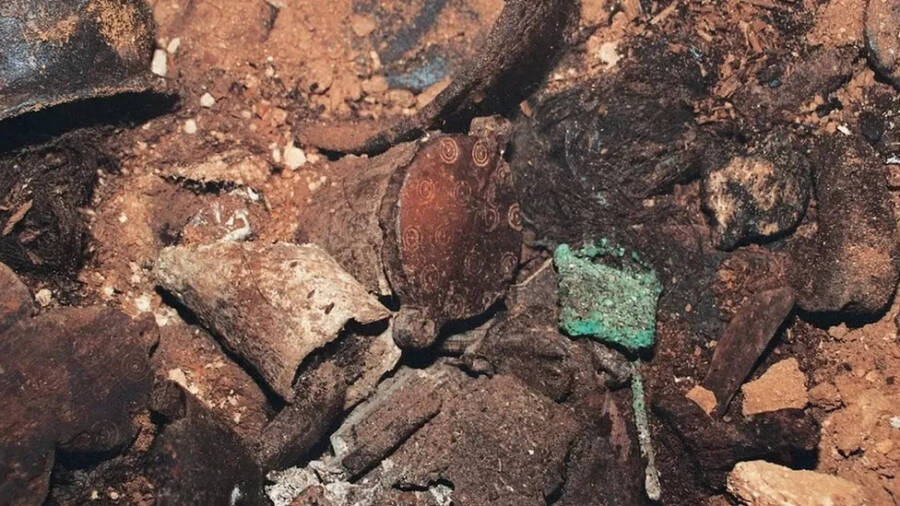After studying the ancient hair strands found in a Spanish cave, researchers confirmed that Bronze Age Europeans consumed hallucinogenic drugs.

ASOME-Universitat Autònoma de BarcelonaThe 3,000-year-old strands of hair that showed signs of psychoactive drug use.
Humankind has a long and complicated history with mind-altering drugs. Researchers and historians have long believed that ancient people around the world understood the effects of different kinds of drugs, particularly hallucinogens and stimulants.
Now, a new study published in the journal Scientific Reports has revealed that through scientific testing on ancient hair strands, researchers in Spain were able to conclusively determine that Bronze Age Europeans consumed hallucinogenic drugs to willfully alter their consciousness as early as 3,000 years ago.

This finding stemmed from an excavation of a single cave in Menorca, an island in the Mediterranean off the eastern coast of Spain.
Called Es Càrritx, the cave was discovered in 1995, and researchers soon learned it had long functioned as a burial site. Archaeologists studying the site found roughly 210 bodies of Bronze Age Europeans there — and among these remains, several decorative tubes filled with clumps of hair.
The hair strands, which researchers dated to about 3,000 years ago, measured roughly five inches long and were a reddish color. Researchers tested the hair samples by breaking them down chemically using mass spectroscopy and ultra-high-performance liquid chromatography.
Using this method, the team discovered traces of several hallucinogenic drugs that grow on the island: devil’s snare, white henbane, mandrake, and joint pine. These plants contain the compounds atropine and scopolamine, which when consumed can result in disorientation, sensory disruption, and often violent hallucinations. Scientists also found ephedrine, a compound that increases alertness.
Additionally, as the cave chamber the tubes were found in had remained untouched since 800 B.C., researchers ruled out the possibility that external contemporary forces had contaminated the hair samples.
Instead, it appears the drug compounds entered the hair after consumption. Further testing showed that those the hair belonged to had ingested the drugs for months leading up to their deaths.
Researchers rejoiced at the findings, calling it the first definitive proof of psychoactive drug use among Bronze Age Europeans.
“We are presenting the earliest evidence of drug consumption in European prehistory,” Elisa Guerra-Doce, associate professor of prehistory at the University of Valladolid in Spain and co-author of the team’s study, told CNN.

Consell Insular de MenorcaResearchers found the human hair inside this decorative tube. The top of the tube features swirl motifs.
While researchers now have proof that Bronze Age Europeans consumed psychoactive drugs, there still is no clear answer as to why.
“This was not a profane purpose of ‘searching for a high’ but more generally the search for existential meaning that has been largely lost to time,” hypothesized Giorgio Samorini, an ethnobotanist who was not involved in the team’s study, as reported by the New York Times.
According to Smithsonian, the swirl motifs on the hair tubes could symbolize the “inner vision” ancient people would experience while on psychoactive drugs.
Others believe that ancient ancestors used psychoactive drugs as part of religious ceremonies. Given that many of the hair samples containing traces of psychoactive drugs were dyed red, researchers believe that spirituality may have played a role in their use.
“We suggest that maybe there were certain people — religious specialists — who controlled their use of these drugs,” Guerra-Doce stated to CNN. “All this evidence made it seem that maybe certain individuals deserved this hair treatment, and those individuals were the ones who consumed the drugs.”
Regardless of the indirect evidence supporting these theories, these statements will remain hypotheses until researchers gather more evidence.
“In order to prove [our theories] we’d have to carry out more analysis on different individuals,” Guerra-Doce clarified.
For now, researchers are ecstatic about their lucky find. While researchers had long inferred that Bronze Age societies used these drugs based on indirect evidence, such as residue on pottery and geographic proximity to psychoactive plants, psychoactive drugs are “usually invisible in the archaeological record,” according to the Smithsonian.
Now, there is conclusive evidence that Bronze Age people used psychoactive drugs. As Guerra-Doce told National Geographic about the finding, “We are very, very lucky.”
After reading about psychoactive drug use in the Bronze Age, read about the history of peyote, a tribal hallucinogen used by the Navajo. Then, read about how scientists are studying hallucinogenic mushrooms to treat depression and other mental health issues.





